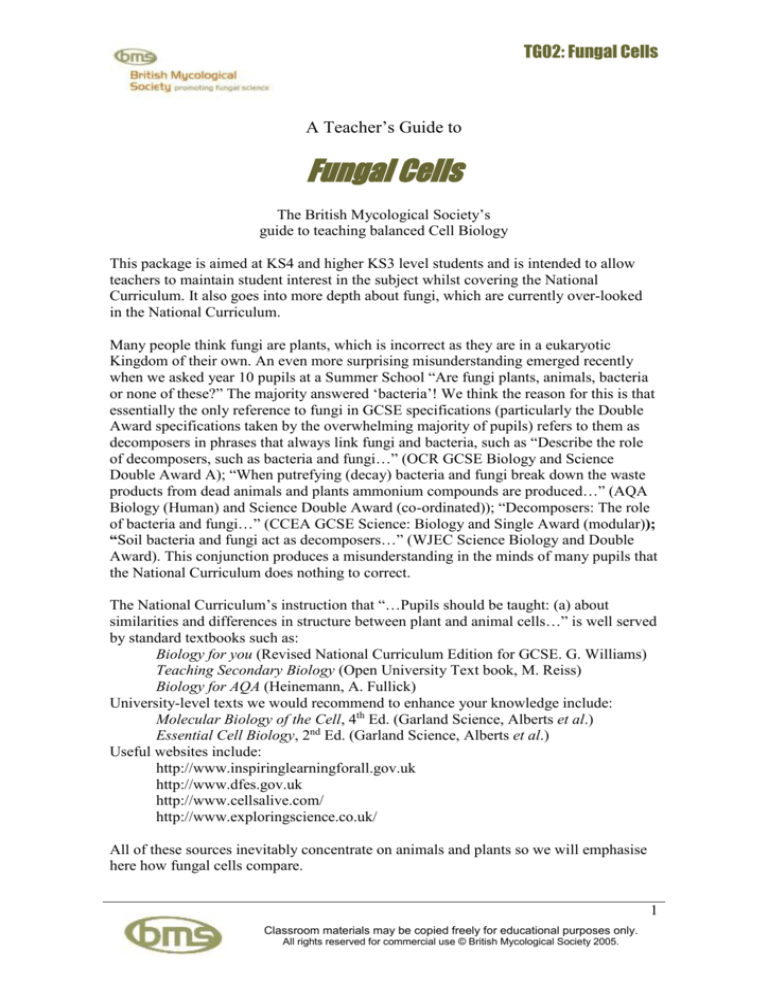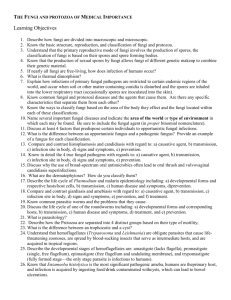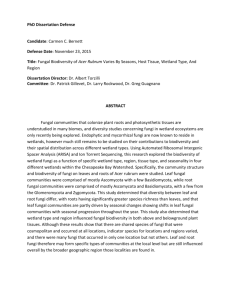
TG02: Fungal Cells
A Teacher’s Guide to
Fungal Cells
The British Mycological Society’s
guide to teaching balanced Cell Biology
This package is aimed at KS4 and higher KS3 level students and is intended to allow
teachers to maintain student interest in the subject whilst covering the National
Curriculum. It also goes into more depth about fungi, which are currently over-looked
in the National Curriculum.
Many people think fungi are plants, which is incorrect as they are in a eukaryotic
Kingdom of their own. An even more surprising misunderstanding emerged recently
when we asked year 10 pupils at a Summer School “Are fungi plants, animals, bacteria
or none of these?” The majority answered ‘bacteria’! We think the reason for this is that
essentially the only reference to fungi in GCSE specifications (particularly the Double
Award specifications taken by the overwhelming majority of pupils) refers to them as
decomposers in phrases that always link fungi and bacteria, such as “Describe the role
of decomposers, such as bacteria and fungi…” (OCR GCSE Biology and Science
Double Award A); “When putrefying (decay) bacteria and fungi break down the waste
products from dead animals and plants ammonium compounds are produced…” (AQA
Biology (Human) and Science Double Award (co-ordinated)); “Decomposers: The role
of bacteria and fungi…” (CCEA GCSE Science: Biology and Single Award (modular));
“Soil bacteria and fungi act as decomposers…” (WJEC Science Biology and Double
Award). This conjunction produces a misunderstanding in the minds of many pupils that
the National Curriculum does nothing to correct.
The National Curriculum’s instruction that “…Pupils should be taught: (a) about
similarities and differences in structure between plant and animal cells…” is well served
by standard textbooks such as:
Biology for you (Revised National Curriculum Edition for GCSE. G. Williams)
Teaching Secondary Biology (Open University Text book, M. Reiss)
Biology for AQA (Heinemann, A. Fullick)
University-level texts we would recommend to enhance your knowledge include:
Molecular Biology of the Cell, 4th Ed. (Garland Science, Alberts et al.)
Essential Cell Biology, 2nd Ed. (Garland Science, Alberts et al.)
Useful websites include:
http://www.inspiringlearningforall.gov.uk
http://www.dfes.gov.uk
http://www.cellsalive.com/
http://www.exploringscience.co.uk/
All of these sources inevitably concentrate on animals and plants so we will emphasise
here how fungal cells compare.
1
Classroom materials may be copied freely for educational purposes only.
All rights reserved for commercial use © British Mycological Society 2005.
TG02: Fungal Cells
Cells
The most important point to make is that animals, plants and fungi are all EUKARYOTES,
so a clear distinction should be emphasised between all of these organisms and the
PROKARYOTIC cells of bacteria. Comparison diagrams are included on the class sheets.
It was first discovered about 170 years ago that all living things are made up of cells.
Robert Hooke used a microscope in the seventeenth century to look at slivers of cork;
he discovered it consisted of “a great many little boxes”. This comparison to boxes led
to the name ‘cells’. In 1838 it was concluded that plants are made up of cells and the
following year the same discovery was made with regard to animals. Fungi have cells,
too, though their biology differs greatly from both animals and plants. Every plant,
animal or fungus is made up of a vast colony of individual cells performing specialized
functions that are coordinated by communication systems. Although from the outside
species look different, all living things are fundamentally similar inside.
A cell is a small, membrane-enclosed unit filled with a concentrated aqueous solution of
chemicals. Cells have the ability to produce identical copies of themselves by growing
and dividing in a process called mitosis. The simplest life forms on earth are singlecelled organisms and the most complex include organisms like ourselves, which are
made up of communities of cells derived by the growth and division of a single founder
cell. It can be said, therefore, that cells are the fundamental units of life.
Cells from different organisms differ from each other although they generally carry out
the same basic functions. All cells have the same basic features. These common features
include a cell membrane, a semi-fluid substance called cytosol (cytosol is known as
cytoplasm when it contains organelles), chromosomes that carry DNA, and tiny
organelles called ribosomes that produce proteins. The characteristic organelles of
eukaryotes are nuclei, mitochondria and the endoplasmic reticulum (also known as
Golgi apparatus). Other more specialist features are present in specific cells such as the
cell wall present in plant and fungal cells, and chloroplasts in plant cells. All cells are
made up of four major chemical components: proteins, nucleic acids, lipids and
polysaccharides. Together, these are known as macromolecules. It is the chemical
nature and arrangement of these macromolecules in a cell of one organism that makes it
different to that of another.
Most bacteria are single-celled organisms (there are some filamentous bacteria called
actinomycetes) and have the simplest structure; in particular they contain no membranebound organelles (that is, no nucleus, no mitochondria, no endoplasmic reticulum, no
chloroplasts). The simplest classification of cells is whether or not a cell has a nucleus;
if it does it is classed as a eukaryotic cell, those that don’t are classed as prokaryotic.
Therefore, bacteria are prokaryotic cells.
The basic bacterial structure consists usually of a semi-rigid protective coat called a cell
envelope; a plasma membrane which encloses the cytoplasm and acts as a selective
barrier; organelles which synthesize proteins called ribosomes; a nucleoid - the region
where the cell’s DNA is located; pili, which are attachment structures on the surface;
and some have flagella which provide the cell with locomotion.
2
Classroom materials may be copied freely for educational purposes only.
All rights reserved for commercial use © British Mycological Society 2005.
TG02: Fungal Cells
Fungi are eukaryotes, just like animals and plants. Although they have the same basic
genetic structures as animals and plants, there are some differences arising from the
fungal lifestyle that need special explanation. Fungi can exist as single-celled organisms
(yeast) but most commonly exist in the multi-cellular form (‘filamentous moulds’) when
they are typically made up of a network of tiny filaments called hyphae. Hyphae make
up an interwoven mass called a mycelium that surround and infiltrates the material on
which the fungi feed and allow efficient uptake of nutrients. Fungal cell walls contain
chitin, this polysaccharide is not present in plants but is present in insects and other
arthropods.
In animals, even lower animals, the movement of cells and cell populations plays a
crucial role in the life of the organism. So cell migration (and everything that controls it)
is a key feature of all aspects of animal biology
Plant cells, on the other hand, are encased in walls and have little scope for movement
relative to each other. Changes in shape and form in plants depend on control of the
orientation and position of the mitotic division spindle, because the new cell wall which
will separate the parental cell into two daughters arises at the equator of the mitotic
division spindle. Consequently, the orientation and position of the dividing parental
nucleus will determine the orientation and position of the daughter cell wall (and the
relative sizes and shapes of the daughter cells).
Fungi are also encased in walls; but their basic structural unit, the hypha, has two
peculiarities that make them totally different from plants and animals. These are that
hyphae grow only at their tips and that cross-walls form only at right angles to the long
axis of the hypha. Hyphae are NEVER divided down their long axis. No amount of ‘cell
division’ in fungi will turn one hypha into two hyphae. Instead, a hypha must branch to
create a second growing hyphal tip. To make a fungal tissue in an organised way, the
position(s) at which branches emerge and their direction(s) of growth must be
controlled.
The above summarises the basic background information we think necessary to convey
a balanced understanding of basic cell biology at GCSE level. The accompanying
collection of class sheets offer several different ways in which to fit this information
into KS3 Module 7a, Cells; and into the year 8 module on Microbes
[www.exploringscience.co.uk]. The next page is an annotated index to the class sheets
included in this package.
These class sheets contain a brief description of animal and plant cells and include
something about fungi and about bacteria. They are designed to be used as supplements
to GCSE textbooks, and/or teaching websites (like www.cellsalive.com). Pupils can also
be encouraged to research the Internet – try Ask Jeeves for Kids at
3
Classroom materials may be copied freely for educational purposes only.
All rights reserved for commercial use © British Mycological Society 2005.
TG02: Fungal Cells
http://www.ajkids.com or Yahoo for kids at http://www.yahooligans.com by typing in
‘Cell structure’ or a cell organelle such as ‘nucleus’ or ‘cell wall’.
Fungal Cells
Annotated index to Class sheets
FC01
General description, concentrating on fungi, so
intended as a supplement to the ‘standard’ National
Curriculum inadequate comparison between
animals and plant cells. Provided in two formats:
PDF file (for easy printing) and as a Word.doc for
you to edit and modify as you wish. Deals with the
same information as FC02+FC03 and intended as
an alternative to those.
FC02
Concentrates on the ‘standard’ National
Curriculum inadequate comparison between
animals and plant cells (intended to be combined
with FC03 which mostly deals with fungi). There
are two sheets here; the first is more appropriate for
KS3, the second for KS4. Provided in two formats:
PDF file and as a PowerPoint PPT file (for editing).
FC03
Quick revision of the animal/plant cell comparison
then concentrating on fungi (intended to be
combined with FC02). Provided in two formats:
PDF file and as a PowerPoint PPT file. The sheets
are designed to be printed on A4 and then folded to
make a little A5 leaflet.
FC04
A single sheet revising the four-way comparison of
bacterial, animal, plant and fungal cells. Provided
in two formats: PDF file and as a PowerPoint PPT
file.
Remember: class sheets may be copied freely for education purposes
4
Classroom materials may be copied freely for educational purposes only.
All rights reserved for commercial use © British Mycological Society 2005.
TG02: Fungal Cells
5
Classroom materials may be copied freely for educational purposes only.
All rights reserved for commercial use © British Mycological Society 2005.







